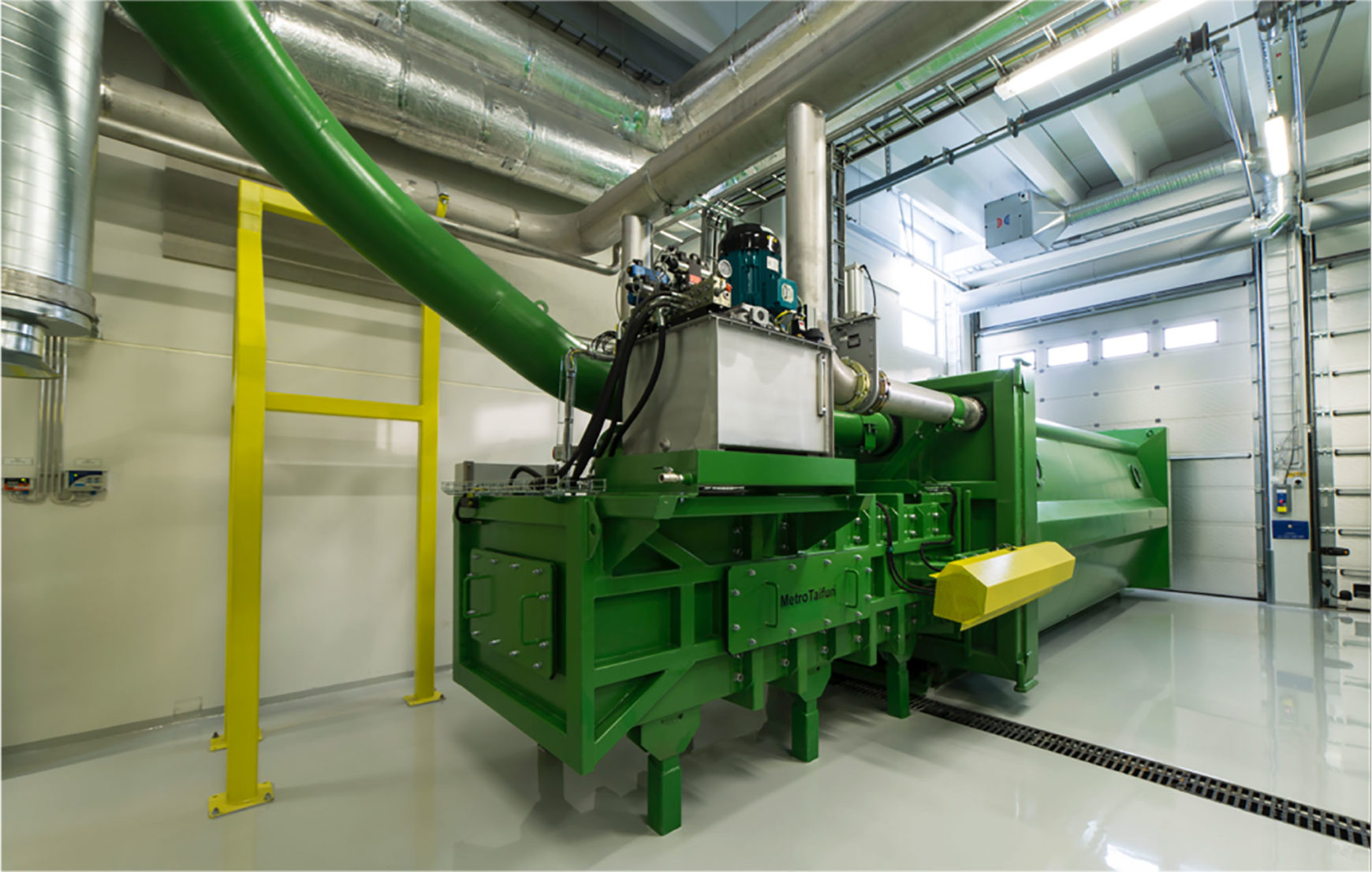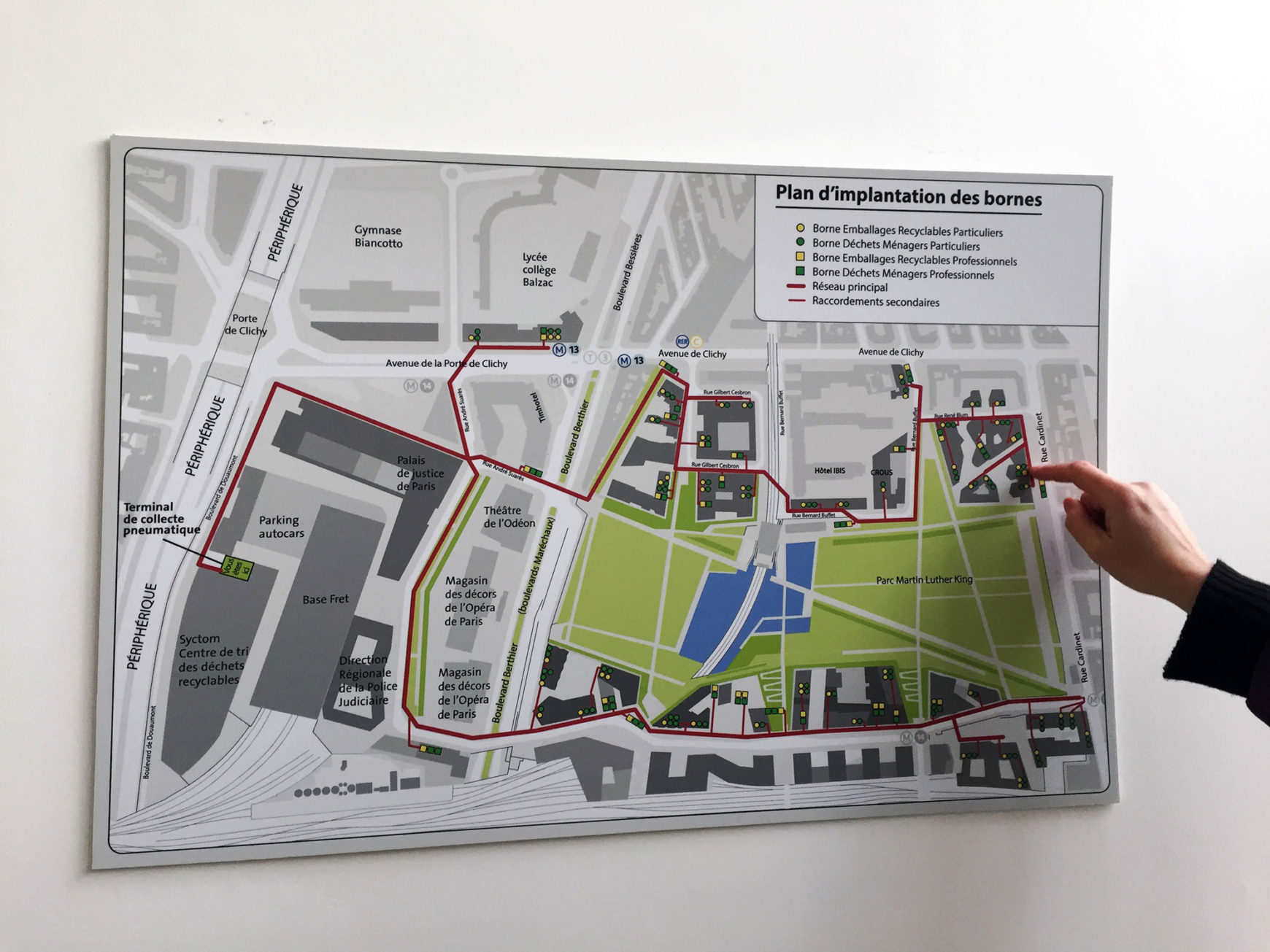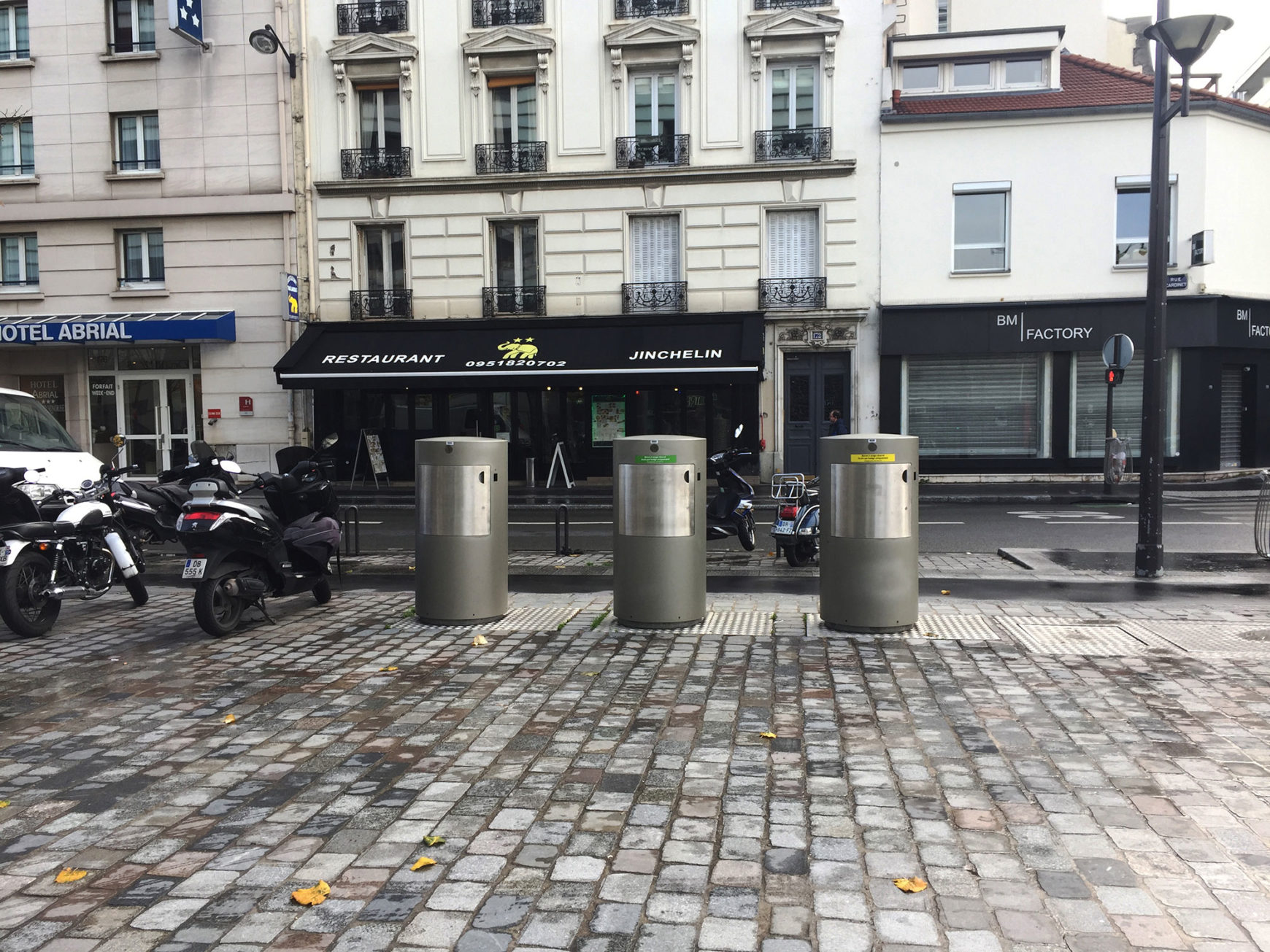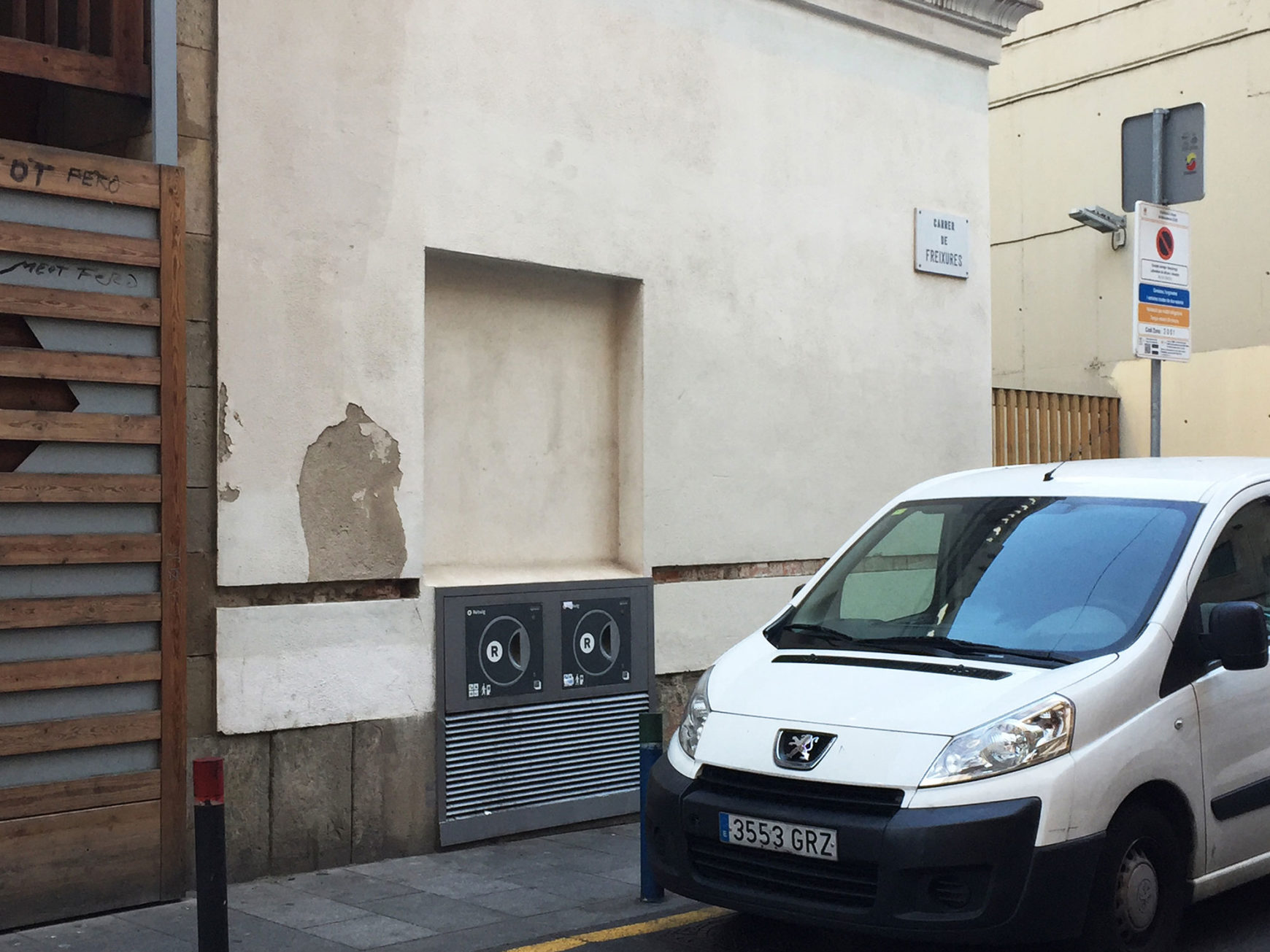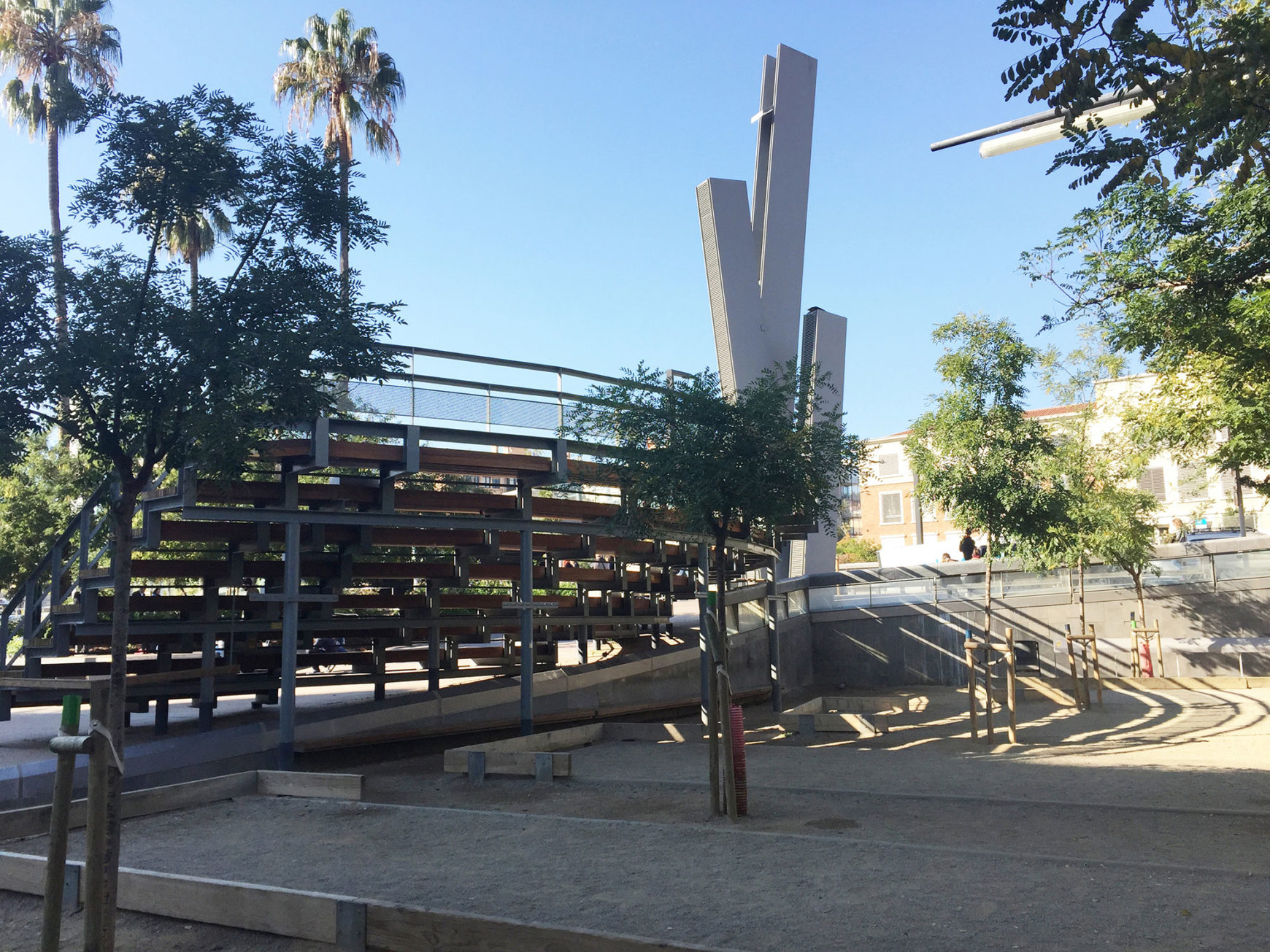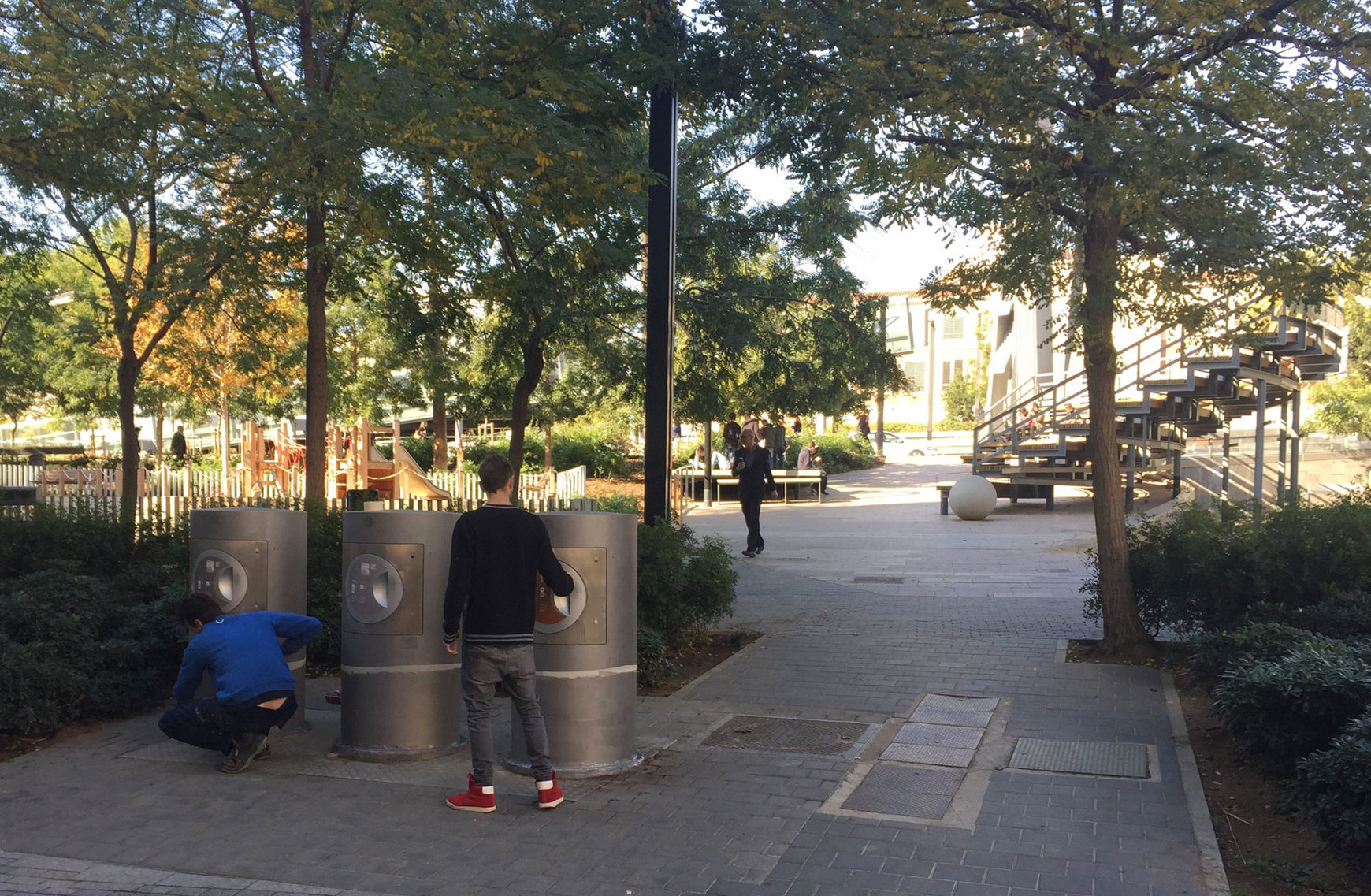Thousands of tons of discarded materials pass through New York City buildings, across sidewalks and into collection trucks, day and night. The best practices listed below describe how efficient transfer of these materials can be incorporated into land use planning, street design and community development. While many of the strategies are not applicable to architects designing a single building, they are applicable for many of the larger developments currently going up around the city. These strategies may encourage developers to look across their portfolio of properties and propose new solutions as an amenity to residents and staff. Building managers and business improvement districts (BIDs) can use them to develop new arrangements that support their neighborhoods.
These strategies describe how communities can manage material flows through a distributed network of hubs to reduce local impacts of collection and increase the resiliency of the system as a whole. While these alternative modes of collection are relatively rare in NYC and there are significant logistical challenges to solve, with the political will, and collaboration between public and private stakeholders, the process could be accelerated. In the last decade, NYC revamped its streets and public spaces to be safer and greener, with more trees, public plazas and bike lanes. (See DOT’s Street Design Manual.) Further redesign would allow the city to better manage the increasing material flows that accompany increasing density.
Also, for much of our existing building stock, the only good solutions involve consolidation within other buildings and public spaces. For existing neighborhoods, the process will need to be iterative and done in collaboration with local stakeholders and communities—as in the public plaza program—with an array of pilot projects that are evaluated, improved upon and developed in other locations. For larger new developments, standards and incentives could require or encourage private developers to employ these strategies that benefit the city as a whole.

Manhattan intersection redesigned to include pedestrians and cyclists
Neighborhood-Scale Collection
Door-to-door collection, or collection by individual businesses within a building, maximizes the number of truck stops, trips and miles. Anytime waste and recyclables can be aggregated between buildings (or between businesses within a building) via pushcarts, small electric vehicles or pneumatic tube, truck miles are avoided, along with the attendant economic, environmental and public health costs. The efficiencies thus achieved can be used to divert more materials from landfills with lower net costs and impacts. Neighboring buildings, along with local organizations such as BIDs providing sanitation services, could coordinate their waste collection by sharing containers at central collection points. ← “(NYC) DOT will explore opportunities for micro freight distribution centers in highly congested commercial areas. These centers might be sited in curb space now dedicated to commercial loading, encouraging off-hour delivery and more efficient collection of recycled materials and waste.” NYC DOT, Strategic Plan 2016, 105, link.
Individual Building Considerations
- Equipment for moving waste to central location
- Coordination between building managers and system operator
Planning Considerations
- Location of centralized facility relative to individual buildings
- Number of streams managed in centralized location
- Network infrastructure, if applicable
- Responsibility for operations and maintenance
- Administrative structure for system management, if multiple stakeholders
- Communication strategy
- Shared costs
3.01 PROVIDE LOADING AREA AT BASE OF A BUILDING THAT CAN ALSO BE USED BY OTHER BUILDINGS
Building staff from neighborhood buildings cart material to one of several single-bay loading areas once a day. (See Battery Park City case study.)
Considerations
- Siting and location of compactors
- Timing of access to compactor and staffing
- Number of streams managed

Building staff consolidating waste at a shared collection point
3.02 PROVIDE CENTRAL COLLECTION FACILITY WITH MULTIPLE COMPACTOR CONTAINERS SHARED BETWEEN BUILDINGS
A dedicated collection truck and crew collects material from all buildings in a development and transports it to compactors in a central facility several times per week. (See StuyTown case study.)
Considerations
- The type of collection truck (rear-load compactor, pickup or box) will depend on the volume of material and whether the truck also used for auxiliary waste storage, or other tasks in the development.
- Consider low- and zero-emission vehicles and cargo bikes.
- Coordinate routes with collection from litter bins on the property.

Exterior yard at Morningside Gardens
3.03 Provide a system of pneumatic tubes connecting buildings to a central terminal
Pneumatic tube networks have been used for trash collection in dense residential developments since the early 1960s, when the first systems were installed in Sweden. Since then, they’ve been incorporated into urban mixed-use urban renewal projects in historic city centers and other sites where truck access is limited, as well as in mega developments in Asia and the Middle East. In the U.S., the only municipally operated system is on Roosevelt Island in New York City.
In lieu of collection trucks, a pneumatic tube connected to individual buildings can convey separate waste fractions (refuse, recyclables, organics) through a common trunk line to a central collection terminal by pulsing the fractions at different time intervals. The pneumatic connections for individual buildings are either in chutes
on individual floors or are inlets on the ground floor or building exterior. Typically, material is transported from these inlets to the collection terminal three to five times a day.
The availability of automatic collection 24 hours a day, 7 days a week minimizes space and labor requirements for individual buildings while providing a range of other public and private advantages because of the elimination of collection trucks, storage and staging of bags or containers at the curb and potential disruptions to collection due to weather or other events. At the collection terminal, the separate streams are compacted into containers for transport to the processing or disposal facility for each material type. (See Roosevelt Island and Vitry-sur-Seine case studies.)
Input Types
- Gravity chutes
- Inlets in lobby
- Inlets in courtyard or street
- Input by building staff or residents
- Addition of pedestrian litter bins
- Separate inputs for commercial and residential users with keyed access for billing and SAYT
Considerations
- The cost of laying pipe is reduced when it’s installed with other utilities like gas and water.
- Design the system layout to maximize energy efficiency, including caps on electricity use in procurement specifications and contract documents.
- For maximum benefit, work with stakeholders and relevant agencies to ensure all waste that can be managed by the system is collected by it.
- When possible, locate pipe in a utility corridor to facilitate long-term access for maintenance, repair and reconfiguration. ← Some maintenance issues on Roosevelt Island result from the fact that steel pipe is direct buried and is inaccessible where it passes under buildings. David Stone, “Challenged Daily by a Mixed Bag of Problems, Engineer Tom Turcic Tends Roosevelt Island’s Aging Infrastructure,” in Main Street Wire (11/7/2009): 10.
- Compactor container fed by pneumatic tube; Map of pneumatic pipe network at Clichy-Batignolles (collection terminal is at far left)
3.04 Provide a system of pneumatic tubes connecting shared inputs to a central facility
Rather than sharing loading docks for compactors emptied by truck, buildings could share pneumatically collected containers. This aggregated-inlet approach could lower the barriers for retrofitting pneumatic networks in existing neighborhoods and significantly increase the capacity and public benefits of individual networks. Some benefits of traditional pneumatic collection for individual buildings are lost: Labor is required to move material to the shared input point and storage is required inside the building , as well as all storage requirements for material handled by the system. But this hybrid approach can still increase collection frequency for waste and recyclables from several times a week to every day and offer service during holidays and extreme weather events. Because drop-off points wouldn’t have to accommodate container loading and container does not have to be at street level, inlets could be co-located with distribution of inbound deliveries or community drop-off for other materials. Material is transported from the aggregated inlets to the pneumatic terminal two times a day. (See High Line Corridor case study.)
Considerations
- See BPS 3.01 considerations for shared loading area.
- See BPS 3.03 considerations for pneumatic network.
- Consolidated collection points for waste streams; bags from street litter bin stacked at curb
Access to Efficient Collection and Recycling as a Public Amenity
In many NYC neighborhoods, commuters head to work by walking to subway stations rather than driving from their garages. With the advent of Citi Bike, many bike commuters are walking several blocks to a bike dock instead of hassling with storing their personal bikes in small apartments. Well-designed drop-off collection points on street corners and public plazas could address inadequate storage in individual buildings. (See Paris Trilib’ case study.)

In Barcelona, residents and small businesses bring recycling to shared surface containers (right) and trash and organic waste to pneumatic inlets (left)
Planning Considerations
- Size and location collection equipment
- Number of streams co-located
- Space required
- Maximum distance from users
- Coordinate with street design (public realm) and open-space planning (private property)
- Utilities (when siting underground containers and tubes)
- Truck access
Operational Considerations
- Maintenance and security (similar to other street furniture)
- Communication and outreach to public
3.05 Provide shared surface containers in the public realm or on public agency property
These could be wheeled bins or crane-hoisted 1–8 cu yd containers, commonly used in European cities. They can be used by building staff for aggregated collection for multiple buildings or businesses, with lockable inlets that restrict use to known generators and allow SAYT billing. Or they can be used for pedestrian drop-offs of low-volume fractions, such as textiles or e-waste, to provide convenient local access to such source-separated materials while minimizing collection costs and impacts. Well-designed and -maintained facilities of this sort are a neighborhood amenity. (See Paris Trilib’ case study.)
Considerations
- Size and capacity of containers versus collection frequency
- Design of containers or container enclosure
- Sufficient curb space
- Siting and distance from users (particularly in front of residential buildings)
- Responsibility for maintenance
- Directly truck accessible, or wheeled bin within an enclosure
- Whether the trucks/equipment configurations needed to collect such containers are compatible with the attachment of snowplow equipment ← New York relies on the use of the DSNY fleet for snow removal. Citizens’ Budget Commission, “12 Things New Yorkers Should Know About Their Garbage” (5/2014): 14, link.
3.06 Shared submerged containers in the public realm or on public-agency property
The same types of containers that are placed on the curb can buried in an underground vault with only a small inlet above the surface. Containers can be raised on a lift and wheeled to a truck, or lifted out and emptied by a collection truck with an attached crane. Submerged containers offer the advantage of minimal intrusion on the curb relative to surface containers of the same size. First used in European cities, submerged containers are now used in several Canadian cities and were recently installed in Kissimmee, Florida, to provide aggregated collection for business and municipal waste and recyclables. Hoist cranes can be retrofitted onto a conventional truck chassis. (See The Hague case study.)
Considerations
- Increased cost compared to surface containers
- Coordinate with existing conditions of site, including underground services, overhead clearances and adjacent land uses
- Vault is the most expensive part, consider planning space for future containers/streams
- Truck access for emptying container
- Security during emptying
- Responsibility for maintenance
- Keyed inlets for SAYT tracking
- For DSNY collection, issue of equipment compatibility with snow removal, as discussed above

In Kissimmee, Florida, the first US city to install submerged containers, a standard collection truck modified with a hoist that can be used with both submerged and surface containers
3.07 Staffed drop-off locations
Drop-offs can be sited at locations with convenient, high-volume pedestrian access points, such as organics drop-offs at subway stations or Greenmarkets. (See GrowNYC, Punt Verd and Ménilmontant case studies.)
Considerations
- Coordination with other collection options
- Siting
- Fixed location or mobile
- Timing
- Outreach
- Collection streams
- Community partnerships
- Responsibility for maintenance
- For DSNY collection, issue of equipment compatibility with snow removal, as discussed above
Integrated Planning
The use of our streets changes over time with shifts in modes of transportation, freight distribution systems, technologies for supplying power and information, and activity patterns. And our streets and public spaces need to meet many needs within constricted boundaries. Construction and maintenance operations—such as surface paving and utility and sewer installation and repair—need to be coordinated, as do the physical design and placement of features such as intersections, curb extensions and street furniture. Compared to the movements of people and goods, the flows of water, sewage, gas, electricity and information; the public safety requirements of firefighting, policing and emergency medical services; the provision of plantings, signage and other visual and environmental features—and especially, the use of curb space for parking—the predictable and inevitable outbound movement of wastes and recyclables seems to be the subject of afterthought rather than planning. This needs to change. The collection of waste and recyclables needs to be integrated into this overall public space planning context.
3.08 Design streetscapes that allow curbside access to containers
New York is increasingly anomalous in the developed world, in that the use of automated and/or aggregated collection of containerized waste and recyclables is relatively rare. A major reason for this is that lines of parked cars prevent access between materials placed at the curb and automated collection trucks. Our streets—and their uses—could be modified to accommodate this smoother, less costly, less polluting form of collection. Flexible street design could allow collection on certain days and uses such as loading or parking on other days. While beyond the scope of this guide, such changes could also accommodate many other desirable objectives, ranging from traffic calming and runoff control to social spaces and street greening. (See BPS 2.04 and Chapter 4. Also see Paris Trilib’ case study.) ← “Bags were still being used in 4% of the surveyed communities.” “The 2016 State of Curbside Report,” The Recycling Partnership, (1/31/2017): 12, link.
- When Plaza Lesseps was built in Barcelona, a pneumatic terminal was inserted under the new plaza to serve the neighborhood; the angular streetlighting is also the stacks for the pneumatic terminal.
3.09 Incorporate community into collection operations
Designers can support conventional outreach and education efforts by finding ways to dignify the act of properly discarding material and making waste flows visible, not as a crisis, but as a source of pride. Substituting thoughtfully designed combinations of public and private space containers and collection systems for the amorphous piles of bags that currently line our curbs should bring us closer to this goal. Increasing the degree of social interaction around waste management activities—and peer awareness of neighbors’ behavior—can lead to a higher degree of source separation, better compliance with recycling regulations and a greater concern for the public space equipment used at drop-off points. (See The Hague, GrowNYC, and High Line Corridor case studies.)
Considerations
- Availability of metrics
- RFID or other technology for associating deposit volumes with individual users
- Adopt-a-container programs to encourage neighbors to keep bins emptied and clean
- Volunteer waste ambassadors who can share information and generate support
- Mentorship for building staff, residents and businesses

Share this page Next Section: Collection & Urban Design Case Studies →
